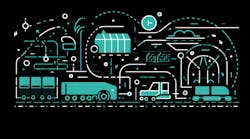If nothing else, these past several years have taught the industrial manufacturing sector plenty of hard-earned lessons about why supply chains were so prone to disruption, and how important collaboration beyond company walls is to minimizing disruptions going forward.
From equipment manufacturers to chip manufacturers, companies across the manufacturing value chain are realizing that to create a more resilient and efficient supply chain, they’ll need to willingly share certain information in real time. That could include information from multiple tiers of suppliers about inventory, production capacity (current and planned), forecasted sales and demand, quality, deliveries, and potential bottlenecks across multiple tiers of suppliers. The goal: give all members of the value chain visibility into the availability and whereabouts of equipment and components so potential disruptions can be anticipated sooner, and so companies can quickly and collaboratively mobilize to address any disruptions that do arise.
This level of visibility is also critical to ensuring that companies (and entire supply chains) can fulfill their mounting carbon-reduction and ESG (environment/social/governance)-related responsibilities. To do so, they need track-and-trace capabilities to more closely monitor and manage carbon emissions, resource consumption and other sustainability-related information, giving them a clear line of sight into carbon footprint and other metrics, not only from their own operations but beyond company walls. That means they’ll need to rely on their supply chain partners to provide trusted, auditable data on emissions, resource consumption, material origin and the like.
And let’s not overlook another area where collaboration can bolster resilience, and that’s among factory equipment manufacturers themselves. Because manufacturers often rely on factory equipment from multiple suppliers, data-sharing and cooperation among those suppliers can help optimize the entire manufacturing process, avoid disruptions and boost shop floor production efficiency by minimizing unplanned downtime.
Bringing Value to the Supply Chain
Business networks and industry ecosystems are providing the framework for this level of collaboration. Not long ago, for example, Vestas Wind Systems, a Danish wind turbine manufacturer, moved to a single, unified business network platform in order to gain full data visibility and transparency across its supply chain, which includes thousands of suppliers worldwide to support manufacturing operations around the globe.
Daniel García López, IT director for Vestas, said the end game is “full traceability of our components and complete stock visibility for suppliers so that we can improve planning, optimize spend, and ensure we have the materials we need right when we need them—all in the same platform where we manage our supplier contracts. Ultimately, it’s about supply chain collaboration.”
Vestas expects to capture at least €20 million (in excess of $21 million) in savings over the next five years as a result of supply chain collaboration and end-to-end transparency.
In another recent example of supply chain collaboration enabled by joining a business network, a global manufacturer of earth-moving equipment connected to a business network platform that enables it to share forecast and planning information with strategic trading partners, and incorporate supplier forecast commitments as part of monthly and longer-term planning cycles.
To make all this work, members of the business network must feel confident that sharing data with other entities provides them value and that their data will not be misused. The more members of the value chain that endorse, trust and engage in specific scenarios and use cases via a network, the likelier the network is to deliver value. The more value that stakeholders realize by participating in a network, the likelier they are to engage further in it as they seek to realize more value. To reinforce that confidence, they need the ability to scale the level of transparency and access to information according to the urgency of the issue, the competitive sensitivity of the data, and other factors.
In both the aforementioned examples, a single business network, operated by a trusted party, provides the framework for collaboration. This has become a successful model for many companies across industries.
The Manufacturing-X Factor
At the same time, data ecosystems based on open standards are emerging across the industrial manufacturing landscape to serve as catalysts for building supply chain collaboration. Initiatives like Manufacturing-X are establishing a framework to preserve data sovereignty within a more decentralized data ecosystem that multiple parties can connect to, and that have clearly stated and enforceable standards and rules. Existing business networks can connect to these ecosystems just like individual companies can, as long as their data standards and tech capabilities meet the ecosystem’s requirements.
Members of Manufacturing-X are working to establish “an international, interoperable data ecosystem,” within which “companies will…autonomously and jointly use data across the entire production and supply chain” to build resiliency, sustainability and competitiveness.
The ‘X’ in Manufacturing-X stands for “exchange,” whereby “companies can share…data while still maintaining control over [it]. Companies can individually determine who has access to their data, when and how they may be used. This concept of data sovereignty enables cooperation between all constituents in value creation networks and promotes the willingness to share data.”
Under the umbrella of Manufacturing-X, multiple interoperable data ecosystems, focused on different value chains, are emerging. Catena-X for the automotive industry is expected to go live this fall, while Factory-X, focusing on the industrial manufacturing industry, is still in the early stages of establishing a framework to enable manufacturers that share a factory floor to also share information. Data ecosystems for the chemical industry, high-tech and other verticals also are on the horizon.
Ultimately, collaboration through business networks and ensuring these networks are interoperable with industry data ecosystems through standards are essential steps to making industrial manufacturing supply chains more resilient and sustainable.
Georg Kube is the global head of industry data ecosystems at SAP SE, a provider of enterprise resource planning software.



